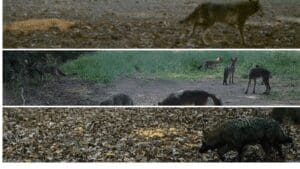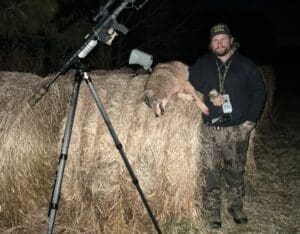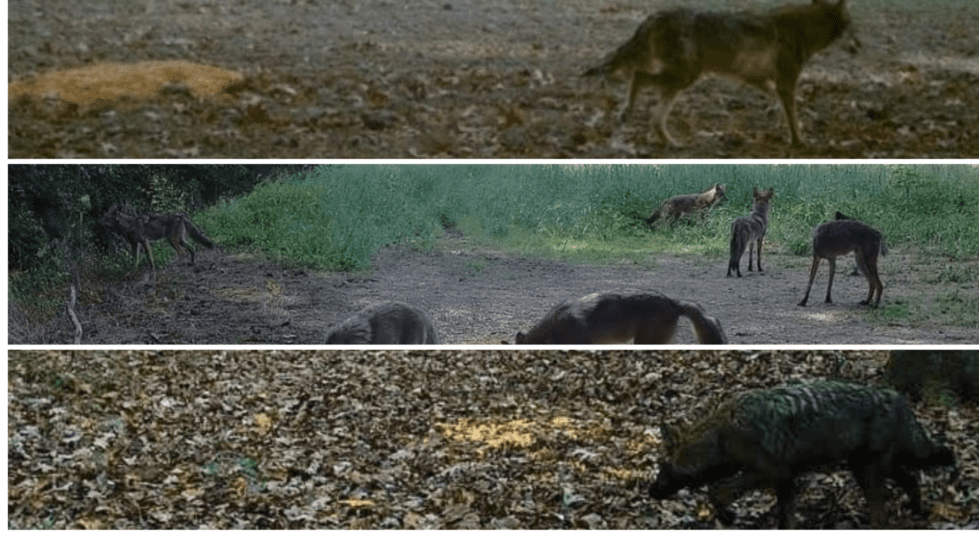
This collage shows coyotoes caught on trail cams in Sussex County. Photos courtesy Jake Klaverweiden/Eastern Shore Predator Control.
A Delmar woman was startled recently to look out her window and see five coyotes attacking a fox in the backyard of her rural cul-de-sac home.
It’s a sign of increased activity during breeding season, said Jake Klaverweiden, the Delmar founder of Eastern Shore Predator Control.
Lots of pets go missing during January through March, he said.
“Coyotes have learned that small dogs and cats are easy prey,” DNREC says on its web page about coyotes.
Klaverweiden and other wildlife experts warn people to keep a close eye on their pets and farm animals, especially small ones.
“Just keep your eyes on your small animals and don’t let them free roam and everything will be fine,” Facebook user Christina Fitzwater advised.
Coyotes are scavengers and will eat any food they can catch or find. They typically hunt alone around sunrise and sunset, making it rare to spot a coyote during the day.
However, that’s not always the case, particularly when it’s time for coyotes to mate.
The coyotes that were in the Delmar woman’s backyard “didn’t seem to be afraid of her,” Klaverweiden said.
DNREC’s website says that when coyote population densities increase or when they find an abundant source of food, coyotes are more likely to hunt in groups.
Coyotes have been in Delaware for at least 10 years, DNREC said.
They are seen on trail cameras, in some vehicle collisions, and hunters and trappers who kill them, DNREC said.
“About a year ago I spotted a coyote in our community, Bay City, in Long Neck,” commented Ryan Leonardo on a Facebook post by Delaware Simply Strong.
“I couldn’t believe what I was seeing,” Leonardo wrote. “I looked it up and they are definitely here in Sussex County.”
Some Delaware residents say they have seen coyotes here for more than decades.
Milton Mayor John Collier said the first coyote he saw was in the 1990s at Cape Henlopen State Park while he was doing work assessing park boundaries for DelDOT.
Collier said there have been no confirmed sightings of coyotes in the town’s incorporated limit, but he has heard reports of their presence in nearby neighborhoods on Cave Neck Road.
“Folks that live out there will say they hear them howling,” he said. They also are getting pictures of them on trail cameras.
“My first coyote I saw (around Ocean View), I was around 8 years old. I’m now 35,” Facebook user Dante Cilia of Sussex County said. “There was just a recent sighting on route 9…by the bridge.”
Klaverweiden said every year he sees more and more coyotes.
“This year has been by far the most,” he said.

Jake Klaverweiden, the Delmar founder of Eastern Shore Predator Control says people are seeing more coyotes because it’s breeding season.
Coyotes adapt
Coyotes are very adaptable and can survive in any environment, including urban and suburban ones.
“In urban environments, dens can be in storm drains, under storage sheds, in holes dug in vacant lots, parks, or golf courses, or any other dark, dry place,” DNREC says.
They also are prolific breeders, with four or more pups per litter born after a 60-day gestation period, and the cubs are relatively self-sufficient by six months old.
With more pups comes the need for more food, and DNREC says the period after coyotes are born is when conflicts between urban coyotes and humans could be more common.
Coyotes can become bold in areas where food is provided by humans.
“They will come up to the door of a house if food is regularly present,” according to DNREC.
STATE MONEY: Gov. John Carney unveiled his proposed $6.1 billion budget Thursday
Do not use food to lure in coyotes for a closer look, DNREC warns. That’s when almost all coyote bites and attacks occur, it said.
To date, there have been no reported attacks on humans by coyotes in Delaware, DNREC reported.
A statewide hunting and trapping season for coyotes was established in 2014 along with a depredation order. It allows landowners to harvest coyotes when there is an imminent threat of injury to people, livestock or pets.
According to DNREC, fewer than five coyotes are harvested in Delaware every year.
Coyotes resemble collie dogs, weighing 30 to 45 pounds, with females smaller than males.
Brownish gray, with a lighter belly, coyotes ears are erect, muzzle slender and have a bushy tail usually held low to the ground.
To avoid conflict with coyotes and deter them from populated areas, DNREC suggests:
- Do not provide food and eliminate sources of standing water
- Elevate bird feeders out if coyotes’ reach
- Secure garbage bins containing edible waste
- Don’t allow pets to run free. Keep them confined and provide secure shelter at night
- If seen around a residence or property, chase them off by shouting, making loud noise or throwing rocks at them.
Klaverweiden said people should be concerned any time they spot a coyote nearby.
“Get out of the area if you can,” he said.
While aggressive behavior toward humans is unusual, it is possible, especially if a coyote is rabid.
Share this Post




